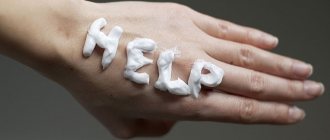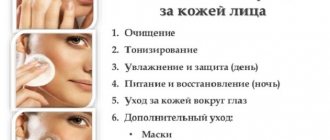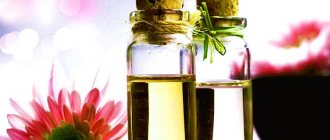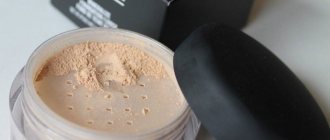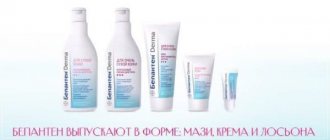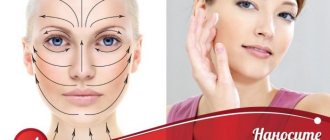Unfortunately, many resort to cosmetics only when they really need help. But it is important to remember that if you take care of yourself regularly, you can avoid a number of problems. Every day we subject our delicate hands to tests - household chemicals, temperature changes, and overall environmental influences. An unpleasant feeling of tightness immediately makes you think about purchasing the best effective hand cream for dry skin.
- Signs and types of dry hand skin
- Causes of dryness
- Features and Action
- Compound
- How to choose a good hand cream
- Rating of the best moisturizing and nourishing creams for very dry hands
- Homemade cream recipes
The choice of this product is currently simply huge. The eyes widen and the buyer immediately gets lost in the “three pines”. And it would seem, what is the difference between them? So he takes the first tube he comes across. Well, or the most beautiful and bright, standing out among others on the store shelf. This is a fundamentally wrong procedure. At a minimum, you simply may not see the result and will be disappointed with the purchase. In the worst case, you will get a low-quality product that will cause harm and lead to an appointment with a dermatologist. To avoid such unpleasant moments, you need to know a few nuances, which we will discuss in this article.
Signs and types of dry hand skin
- tightness;
- peeling;
- redness;
- itching;
- formation of cracks;
- bleeding
All this means dehydration of the epidermis, that is, an insufficient amount of moisture in the stratum corneum. There is a deficiency of amino acids and impaired sebum secretion. This is due to the fact that there are practically no sebaceous glands in this area, and the turnover of epithelial cells is very slow. Most often, the above problems appear in autumn or winter. Firstly, the impact of the environment, and secondly, vitamin deficiency. But in the warm season you can also encounter them. Especially in hot summers under the scorching sun. All this suggests that our hands are very vulnerable and therefore require constant care. There are two types of xerosis:
- acquired;
- constitutionally determined.
In the first case, it is acquired under the influence of external factors. These can be weather conditions (wind, heat, frost), unhumid indoor air, tap water, detergents, and working conditions. It can also often be an excessive number of cosmetic procedures, such as peeling.
In the second case, everything is explained by heredity and individual characteristics of the body. This also includes various diseases, age-related changes, and genetics. Dry skin classification:
- with decreased tone;
- with good.
The latter option is more typical for young people. When the skin is not damaged and does not look painful. Nevertheless, it must be taken care of and moisturized. Otherwise, when exposed to various stimuli, turgor decreases. In the first type, all the signs are well expressed. Tightness, roughness and other “charms” make themselves felt.
How long does it take to treat cracked thumbs?
Cracks and peeling on the hands, phalanges and fingers spoil not only the appearance, but also bring a lot of unpleasant sensations and discomfort when working with your hands.
- Treatment depends on the size of the problem and the cause. If the cracks are shallow and you immediately started the treatment process, then this problem may go away within a few days.
- But if the problem does not go away even after numerous procedures, then treatment may take several years. Therefore, it is very important to consult a specialist in time so that this disease does not cause discomfort in the future.
It is important to find out the cause of the cracks so that they do not recur in the future. Basically, if a problem occurs once, it can happen again if the source or irritant is not removed.
Causes of dryness
As you already understand, there are a lot of them. Let's look at the most common ones.
- Household chemicals. To protect yourself from harmful detergents, or more precisely, from the substances contained in them, you should always use gloves. Do not neglect this rule, otherwise due to constant contact, the protective lipid layer is washed off and the water balance of the skin of your hands is disturbed.
- Somatic diseases. This includes thyroid diseases, diabetes, and oncology. The activity of the sweat and sebaceous glands decreases. In such cases, doctors prescribe corrective therapy and the use of other external medications.
- Allergy. When it manifests itself, the body behaves differently. And dryness, with all its symptoms, can also make itself felt.
- Poor nutrition. Certain foods contain the required amount of water, vitamins and minerals that a person needs to stay healthy. By the way, this includes avocados, walnuts, salmon, leafy greens, turkey and eggs. So, with moderate consumption of them in food, we saturate the body with useful elements.
- Climate. Everything here is clear, but we are not able to influence the climatic conditions, so there is no way to do this without special protective equipment.
When can you start using it?
Regenerating hand creams can be used not only by representatives of certain professions, whose skin becomes very dry and injured during work. Intensive recovery may be required for each of us; the only question is when and under what symptoms can we begin to use effective means.
The opinions of cosmetologists regarding the use of powerful regenerating agents are divided: some believe that the skin of the hands requires intensive hydration from a young age, which will serve as a good preventive measure against premature aging and the occurrence of specific skin diseases. Other experts are categorically against the use of such creams unless absolutely necessary, as well as under the age of 35, since preventive saturation of the dermis with moisture will lead to the fact that it will “forget how” to independently produce the necessary elements to maintain water balance.
Perhaps the second opinion is more correct. The regenerating cream should be used only according to indications - if there is a feeling of skin tightness, severe dryness, peeling and microcracks that cause discomfort. Once positive dynamics are achieved, the treatment must be changed to the usual moisturizing cosmetic compositions.
Features and Action
When buying a cream, it is important to pay attention to the solution to what problem it is aimed at. They are divided into several types:
- moisturizing;
- nutritious;
- anti-aging;
- hypoallergenic;
- protective.
The former are especially in demand, because they perform the main function - they fill cells with moisture, eliminating dehydration. In principle, they may have several distinctive characteristics.
They can be divided into daytime and nighttime, differ in texture, leave a protective oily film or not, additionally moisturize the cuticle and strengthen the nail plate. And of course, practically the most important point - carefully study what is contained in the cream you like.
Prevention
To protect your hands, you need to take preventive measures. Firstly, it is important to choose the right hand cream that will serve as daily protection. Secondly, hands need to be protected from frost, wind, and hard water. It is recommended to use gloves for this. And thirdly, proper nutrition and a healthy lifestyle are the key to a beautiful, elastic and healthy dermis.
There are healing, moisturizing, nourishing, protective creams and many others. You need to choose a product based on your preferences, type of dermis and desired result. To make the right choice, it is recommended to first consult a cosmetologist or dermatologist. With proper use of a cosmetic product, your hands will shine with health for many years, without dryness, wrinkles and cracks.
Compound
Its properties and price will depend on the content of any substances in the product. Be sure to check out the components it includes. If you are prone to allergies, then make sure that there is no element that can cause it.
Usually the tube contains a list like this:
- water (will always be indicated first, the main thing is that it does not exceed 70% of the specific gravity);
- glycerin, lanolin (moisturize the skin, saturate it with nutritious fats, protect against negative environmental influences);
- natural ingredients (a wonderful bonus in the form of useful extracts and vegetable oils will help heal damaged dermis faster);
- vitamins A and E (the first can penetrate deeply and affect the lower layers. The second (tocopherol acetate) stimulates the production of estrogen, that is, rejuvenates);
- silicone (not found in all products; it is added to improve texture);
- urea (used by many well-known brands to add to cosmetic products, maintains moisture levels in the epidermis);
- squalene (an antioxidant that is produced by our skin cells, but becomes less and less as we age. Its main function is to prevent dehydration);
- alpha-bisabolol (a valuable ingredient obtained from chamomile, which has anti-inflammatory properties);
- allantoin (an ideal component that quickly heals damage to the skin and ensures accelerated regeneration);
- emulsion wax (resembles a gray-white substance, presented in the form of small wax grains, it is hypoallergenic, non-comedogenic, does not leave an oily sheen. At the same time, it is well absorbed and softens tissues).
It is important to know not only about the beneficial ingredients, but also about those that should be avoided. These include:
- formaldehyde (also found as formaldehyde, formalin, formic aldehyde, oxomethane, oxymethylene. This is a preservative with an antifungal effect, however, it is very toxic and can cause severe irritation);
- parabens (When accumulated in the body, they can affect hormonal levels, so they are allowed in microdoses);
- aluminum acetate (if peeling occurs when using the product, then the possible reason is Aluminum Acetate);
- propylene glycol (a compound that can also cause irritation);
- bithionol (contraindicated for those with sensitive skin. Otherwise, itching and redness may occur after use).
What not to do
Pediatrician at the Fantasy Children's Clinic, Ph.D. Svetlana Mukhortova does not recommend:
- Lubricate the burn with vegetable oil, cream, sour cream and other fermented milk products. A film forms on the skin, air stops flowing to the wound - it overheats, and the depth of the lesion increases. Lactic acids and fermentation products can introduce microbes into the wound
- treat burned skin with brilliant green, iodine, cosmetic lotions - alcohol dries out the skin and causes burning and pain
- apply bandages with urine to the wound. The effectiveness of urine therapy has not been proven
- puncture blisters - microbes with liquid can enter the wound. The blisters will open on their own - as a rule, this happens when the skin has already been renewed and the wound has “healed”
- remove stuck clothing yourself so as not to injure the burn site
- apply snow and ice longer: burned skin does not feel temperature changes - you can get frostbite
- sprinkle the burn with soda, flour, mustard powder, starch or baby powder - the film prevents cooling, and small particles can fester
- apply tight bandages and seal the wound with adhesive tape - air access is reduced
- rinse with running water if bubbles open - this is painful and can lead to germs penetrating deeper.
How to choose a good hand cream
We have already analyzed the composition and know what to watch out for. Undoubtedly, it is better to choose a completely natural product. It will have a short shelf life, but you do not risk using any preservative to harm your health. If they are still contained in the product you have chosen, then make sure that their quantity complies with the standards. Pay attention to the expiration date.
If you have any skin diseases or are prone to allergies, then first it is advisable to consult a dermatologist. Perhaps he will identify the allergen and help you choose the right cosmetics for you. It is also recommended to apply a small amount of product to a small area of the back of the hand before use. If after 24 hours a negative reaction has not occurred, then you can safely use it. Also pay attention to the presence of flavorings, or rather, their absence.
The next selection criterion is seasonality. For summer, those that spread easily and leave no residue are more suitable. Nutritious and fatty foods are necessary in the autumn-winter period, when we need additional protection. By the way, a product with sun protection properties is useful not only in the warm season, but also in the cold season. You just need to pay attention to the degree of protection.
They can also be nocturnal or daytime. As a rule, the former have a dense texture, while the latter have a more airy texture. Another rule - focus on your age.
Types of wound healing ointments
Before purchasing an ointment for wound healing, ask what exactly it is intended for:
- disinfectant
– protects against infection, intended for treating scratches, abrasions, cuts and cracks of the skin; - antibiotic ointment
- necessary for treating inflamed wounds, often in the presence of pus, ulcers, bleeding wounds, erosions, burns, postoperative sutures; - regenerating
- such an ointment will help abrasions and frostbite heal faster; - drying
– suitable for the treatment of weeping wounds, purulent inflammations, wounds in the mouth.
Homemade cream recipes
The main reason why we recommend trying to prepare it yourself is the confidence that there are no harmful additives, preservatives, or dyes. But consider the expiration date. Usually after two weeks they disappear and become unusable.
- First, make a concentrated chamomile decoction, that is, pour 2 tablespoons of dried flowers into 100 ml of water, bring to a boil and cook over low heat for about an hour, stirring occasionally. Strain and add 1 teaspoon each of shea butter and jojoba oil, 4 drops of sweet orange. Beat everything vigorously. This option is suitable for very dry hands. Maintains moisture levels throughout the day.
- This cream will help speed up the healing of cracks, burns, and scratches. Accelerates the process of natural cell regeneration, perfectly nourishes and moisturizes the epidermis. To 20 ml of decoction from St. John's wort and string, add 1 tsp. natural honey and 1 tbsp. l. butter. Promotes rapid regeneration and nutrition.
- A very effective recipe, the product is enough for one use, it is better to repeat every other day. As a result, you can see for yourself, and how to do it, watch the video at the very end.
But we don’t always have enough free time to prepare natural cosmetics. And then we are helped by high-quality products, which you will find on our website “1mmtt”. We work only with trusted suppliers and guarantee the quality of all products.
Why is a steam burn more dangerous than a boiling water burn?
Let's figure out what steam is. This is the gaseous state of a substance formed when a liquid is heated. There seems to be nothing wrong - the same water. But in fact, steam burns can be much more serious than burns from hot water.
- Firstly, the temperature of boiling water is 1000C, while the temperature of steam, especially under pressure, can be much higher.
- Secondly, when water hits the skin - even very hot water - it is instantly cooled by body temperature (which averages 36.60C). Steam, on the contrary, releases even more heat when it changes from a gaseous state to a liquid state and “settles” as moisture on the skin.
With a steam burn, as with any other thermal burn, part of the skin tissue dies and blood circulation is disrupted. This kind of damage is accompanied by redness and irritation of the skin, swelling, and inflammation. The affected nerve cells “cry out” for help with severe pain.
To immediately help a person who has suffered a steam burn, you must first be able to recognize the severity of the injury.
Steam burns received in domestic conditions come in 3 degrees of severity:
1st degree - the victim experiences slight redness of the skin, the burn site is painful and slightly swollen.
2nd degree - characterized by the formation of blisters filled with liquid at the burn site. This is a moderate burn.
3rd degree – severe burns are characterized by partial cell death. The skin begins to peel off, during the healing process, damaged tissue is rejected, and a scar forms at the site of the burn.
Another important factor for determining the severity of a steam burn is determining the affected area.
For this, the “rule of the palm” is used: based on the calculation that the palm covers 1% of the total area of the skin, you can estimate the area of the burn. Or you can refer to the “rule of nines”, according to which the area is determined as a percentage (multiples of nine) depending on the parts of the body:
- Chest and back – 18% each;
- Legs – 36% (18% each);
- Head and neck – 9%;
- Hands – 18% (9% each).
Contact an ambulance or burn center immediately if the affected area exceeds 10-15% for 1st degree burns and more than 1% for 2nd degree burns. Burns of a large surface of the body lead to burn shock: infection begins, the body is poisoned from the inside by tissue decay products. The cause of death can be a burn with 50% damage to the body.
In addition to steam burns to your hand or finger, there is a risk of other dangerous injuries:
- Thermal damage to the eyes is most often mild or moderate in severity. This is due to the fact that when steam gets into the eyes, they reflexively close. The eyelids can be seriously damaged. Therefore, in any case, you should consult an ophthalmologist to monitor the condition.
- Respiratory tract burns - can develop when inhaling hot steam. During the first 12 hours, there is a risk of swelling of the airways, which can lead to difficulty breathing. Therefore, be sure to monitor the victim’s condition and consult a doctor. Patients suffering from a burn to the respiratory tract may later develop pneumonia.
- Steam burn to the groin area. In case of lesions of this kind, examination by a specialist is required.
Call emergency medical services immediately in the following cases:
- You have identified a 2nd and 3rd degree burn with damage to more than 10% of the skin.
- The victim is a child or an elderly person.
- The head, eyes, and groin area were burned.
- There are open wounds.
While waiting for the doctor, proceed with first aid.
Rescuer
“Rescuer” ointment works as an antiseptic, provides excellent pain relief and relieves inflammation. “Rescuer” helps with bruises, minor cuts, scratches and abrasions. The composition of the “Rescuer” ointment: purified milk lipids, beeswax, sea buckthorn oil concentrate, tea tree oil, lavender oil, echinacea extract, turpentine, vitamin E. As you can see, “Rescuer” is made from natural ingredients, so it has almost no “side effects” and contraindications. This wound-healing remedy will help with burns, minor cuts, frostbite, dermatitis and diaper rash, acne and cracked nipples during breastfeeding. You can buy “Rescuer” in almost any pharmacy; it has an affordable price. But you need to keep in mind that the drug is not intended for complex wounds when there is suppuration.
Rescuer
Alpha Intel Sp, Poland; Lyumi, Russia
Balm “Rescuer” is intended for quick help with various traumatic injuries and acute inflammations of the skin;
for irritations; diaper rash; protection from weathering, sun and frost; for the care of skin damaged by harmful environmental factors. Promotes accelerated healing of fresh wounds and burns without scarring. The absorbable effect of the balm allows you to restore a person’s performance in less than a day in case of sprained ligaments, severe bruises, and superficial hematomas. from 21
5.0 1 review
345
- Like
- Write a review
Actovegin
"Actovegin" is a wound-healing ointment with complex action. The main task of the drug is the destruction of bacteria and tissue regeneration. You can buy Actovegin in the form of ointments, tablets or injections. The drug contains: deproteinized calf blood hemoderivate, povidone. Actovegin increases the concentration of amino acids in the blood and helps heal even old wounds that have not healed for a long time. Actovegin ointment is inexpensive, it lasts for a long time, among the disadvantages is a list of side effects that you should definitely familiarize yourself with.
Actovegin
Nycomed, Switzerland; Takeda, Japan; Kusum Healthcare Pvt. Ltd., India
Actovegin activates cellular metabolism (metabolism) by increasing the transport and accumulation of glucose and oxygen, enhancing their intracellular utilization.
These processes lead to an acceleration of ATP (adenosine triphosphoric acid) metabolism and an increase in the energy resources of the cell. from 231
5.0 2 reviews
4263
- Like
- Write a review
Eplan
A universal anti-inflammatory agent that is recommended for use immediately after injury. "Eplan" quickly stops bleeding, reduces pain, and relieves swelling. You can buy Eplan both in the form of a liquid solution, and in the form of a cream or special napkins soaked in the drug. The active ingredient of the drug is glycolan. "Eplan" can be used to disinfect a wound and destroy pathogenic microflora before applying other wound healing agents. "Eplan" is prescribed for bedsores, frostbite, burns, cuts, abrasions, herpes, ulcers, weeping eczema.
Eplan
Oberon, Russia
Burns of various types: solar, chemical thermal; Frostbite; various skin injuries, including bruises, cuts, wounds, cracks and abrasions; Radiation damage to the skin; Bedsores and trophic ulcers; Psoriasis; Streptococcal or staphylococcal pyoderma; Dyshidrosis (pompholyx, which can be complicated by a secondary infection) or microbial eczema; Acne vulgaris; Papillomavirus infection, the presence of condylomas, herpes or warts; Otitis, otomycosis; Boils in the nose; Sycosis; Swelling and itching from the bites of insects such as mosquitoes, bees, wasps, etc.; Preventive a skin protection product when working with chemicals and aggressive environments, including detergents, fertilizers, solvents, etc. Eplan cream is also used in veterinary medicine for similar diseases of domestic animals.
from 197
744
- Like
- Write a review
Vulnuzan
This ointment for wound healing contains mother liquor of Lake Pomorie, castor oil, tylose C-30, anhydrous lanolin, distilled water. This drug perfectly treats wounds and burns. “Vulnuzan” consists entirely of plant components, does not provoke allergic reactions, helps with wound suppuration, the ointment is suitable for mucous membranes and is quite affordable. Among the disadvantages is that you can’t buy “Vulnuzan” in every pharmacy; the ointment is not suitable for pregnant and lactating women.
Vulnuzan
Sopharma AD, Bulgaria
Vulnusan ointment is a drug with anti-inflammatory, antimicrobial and tissue regeneration-improving effects.
A preparation of natural origin for external use, obtained by processing the mother liquor of Lake Pomorie. It has anti-inflammatory, antimicrobial and tissue regeneration-improving effects. from 124
543
- Like
- Write a review
Dioxidine
This ointment is suitable for the treatment of bedsores and weeping burn wounds. The active ingredient of the drug is hydroxymethylquinoxaline dioxide (antibiotic). “Dioxidin” relieves inflammation, destroys pathogenic bacteria (even the most resistant ones), and promotes the healing of wounds that do not heal for a long time. Apply the ointment to the wound, cleaned of pus and dead particles. The drug can be used in combination with other medications, it has a long shelf life. Among the disadvantages are sales only by prescription and use in patients over 18 years of age.
Dioxidine
OJSC "Nizhpharm", Russia; PJSC "Biosintez", Russia; Novosibkhimpharm OJSC, Russia
Broad-spectrum antibacterial bactericidal drug.
Purulent bacterial infections caused by sensitive microflora when other chemotherapeutic agents are ineffective or poorly tolerated. External use - superficial and deep wounds of various locations; - long-term non-healing wounds and trophic ulcers; - phlegmon of soft tissues; - infected burns; - purulent wounds with osteomyelitis. Intracavitary administration - purulent processes in the chest and abdominal cavity; - for purulent pleurisy, pleural empyema, lung abscesses, peritonitis, cystitis, wounds with deep purulent cavities (soft tissue abscesses, pelvic cellulitis, postoperative wounds of the urinary and biliary tract, purulent mastitis). Treatment of burn and purulent-necrotic wounds promotes faster cleansing of the wound surface, stimulates reparative regeneration and marginal epithelization, and has a beneficial effect on the course of the wound process. from 35
5.0 1 review
839
- Like
- Write a review
Proper wound treatment
Levomekol
The active ingredients of Levomekol wound ointment are dioxomethyltetrahydropyrimidine (methyluracil) and chloramphenicol. The first component destroys most bacteria, the second increases cellular immunity. "Levomekol" is applied in a thin layer to a cleaned and disinfected wound, and a sterile bandage is applied on top. You need to apply the ointment three to four times a day until complete healing. "Levomekol" is suitable for the treatment of both minor cuts and weeping, purulent and thermal wounds that take a long time to heal. Doctors prescribe Levomekol ointment in the postoperative period to help scars heal faster. You can buy Levomekol without a prescription; the price of the drug is budget. Among the disadvantages are the presence of an antibiotic in the composition (and these are additional contraindications), not very convenient application, and some patients may be intolerant to the components of the drug.
Levomekol
OJSC "Nizhpharm", Russia
An ointment that has an antimicrobial, anti-inflammatory, drying effect and is used for: Purulent wounds (including those infected with mixed microflora) in the first (purulent-necrotic) phase of the wound process.
from 38
1236
- Like
- Write a review
Read also : What medications should be in a home first aid kit? Today we’ll talk about what medications should be in a home first aid kit, so that in case of illness or an unexpected deterioration in health, you can quickly help yourself (this could be a headache, an allergic reaction, fever, injury or food poisoning).
Baneocin
Baneocin ointment works as an antiseptic and has a healing effect. You can buy Baneocin both in the form of an ointment (to help the wound heal better) and in the form of a powder (it can be applied immediately after injury). The drug contains two antibiotics: bacitracin and neomycin. "Baneocin" relieves inflammation of wounds and is also suitable for the treatment of pustular rashes. The ointment helps in the fight against umbilical infection in newborns, and is also indicated for the treatment of diabetics. Contraindications include: cannot be used on mucous membranes, with a large area of damage, during treatment with other antibiotics, or with renal failure. Among the disadvantages are the high price and a list of contraindications.
Baneocin
Sandoz, Germany
Infectious and inflammatory skin diseases caused by microorganisms sensitive to the drug: - bacterial skin infections of limited prevalence, incl.
weeping contagious impetigo, infected trophic ulcers of the lower extremities, infected eczema, bacterial diaper dermatitis, secondary bacterial infection in diseases caused by Herpes simplex, Varicella zoster (including infection of vesicles with chickenpox); —prevention of umbilical infection in newborns; - prevention of infection after surgical (dermatological) procedures: for additional treatment in the postoperative period (after tissue excision, cauterization, episiotomy, treatment of cracks, perineal rupture, weeping wounds and sutures). from 183
890
- Like
- Write a review
Nitacid
This wound-healing ointment is well suited for the treatment of purulent wounds. Nitacid contains sulfonamide and nitazole, which destroy almost all known types of bacteria. The drug is prescribed for disinfection of postoperative sutures, treatment of purulent lesions and abscesses. "Nitacid" is also effective for burns of varying degrees. For purulent wounds, apply a tampon with ointment to the damaged area once a day. Burns should be treated twice a week. Among the disadvantages is a list of contraindications (as with any antibiotic), as well as possible individual intolerance to the components of the ointment.
Nitacid
PrJSC Pharmaceutical Company “DARNITSA”, Ukraine
Nitacid is used as a means of local therapy in patients with infected wounds, purulent-inflammatory diseases of the skin and soft tissues (including trophic ulcers, amputation stumps of limbs, bedsores, fistulas, phlegmons, postoperative wounds and abscesses). Nitacid is also indicated for superficial and deep burns of II-IV degree.
347
- Like
- Write a review
